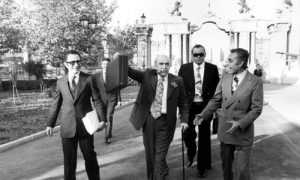۲۵ years between the years 1332 to 1357 S.H. can be considered as the years of the court and the Shah’s attempt to concentrate on power and genesis of absolute regime which had been threatened leaving Reza Khan during 12 years between the years 1320 to 1332 S.H. by rivals such as religious conservationists and landowners in one side and non-traditional opponents like national front and communists on the other side.
This transformation was done step by step gradually. In the first stage which includes the years after Mordad 28th coup to earlier 1340s, the court wasn’t so powerful to be able to remove all rivals at once. In this stage in which five prime ministers gained power including Fadhlullah Zahedi, Hussein Ala, Manouchehr Iqbal, Ja’far sharif Imami and Ali Amini, the court repressed its national forces, religious extremists and communists gradually.[1]
Another challenge was Zahedi due to his role in the coup and being supported by America which caused the Shah to be worried. Additionally, Zahedi tried to enter his candidate into parliament to provide an obedient and dependent one. His attempts in this regard added to Shah’s sensitivities who didn’t agree with dividing power. Intriguing conservationists and traditional forces of parliament to oppose Zahedi were of the Shah’s attempts to set him aside or at least to weaken him.
In this part of time, some religious officials united with the court to remove the rivals. Anyway, what hastened the process of omitting Zahedi was the Shah’s awareness of the American and British interference with changing him. After exiling Zahedi to Switzerland in 1334 S.H. which “was done respectfully but firmly”[2] according to Katouziyan, Hussein Ala gained power. After him, Manouchehr Iqbal and then Ja’far Sharif Imami became prime ministers.
In the elections of the 20th parliament, the mentioned parties were going to occupy the parliament seats and to prevent achieving conservationists to the most important center of legislation, but parliament continued its traditional trend.”[3]
Electing Ali Amini as the prime minister wasn’t optional and electing among various options for the Shah. Reacting the crises of the year 1339 S.H. and the inability of the 20th parliament to solve the dilemmas of the country, the Shah elected Amini rather than electing the candidates of the national front.[4]
The most important plan of Amini’s cabinet were the terrestrial reforms and fighting against the power of economic land owners and feudalists. However, what is paid attention by the Shah in this cabinet wasn’t Amini’s reforms, but his independence from the Shah and being supported by the United States who was considered a as a danger for his absolute power.
By soaring differences between the Shah and Amini concerning army budget, the presence of some characters paid attention by the shah in the cabinet such as Asadullah Alam and also gaining democratic base, he was forced to resign.
Removing Amini provided a necessary chance for the Shah both to execute terrestrial reforms and to perk it as a personal initiative.
In this way, although during 1330s the Shah needed the feudals’ and clergymen’s supports, but at the end of this decade clergymen and landowners became influential barriers on the way of the process of concentration of Shah’s power.
John F. Foran considers “the party system” as one of the dictatorial royal foundations of Pahlavi and assumes its role as a means like oil incomes as important to repress to strength the kingdom.[5] one of the newly-established practices is the modern Iran panty including inexperienced and modern elements.[6]
Iran Novin Party gradually became one of the coteries for the membership and influence of the Baha’is who were interested in meddling with policy. There were 20 people as the executive members of the party among which Amir Abbas Hoveyda, Ataullah Khosrawani, Farrokhrou Parsay, Mansour Rowhani and Manouchehr Shah Gholi and Fathullah Sotoudeh were Baha’is although the Baha’is weren’t allowed to join parties or political organizations.
Ataullah Khosrawani was at the top. He became secretary general supported by the Shah. In this way, due to the necessities and policies of the government, the ability of religious forces of the society to confront against Baha’is became restricted.
Source: Leyla Chaman Khah, Bahaism and Pahlavi regime, Tehran: Negah-e-Moa’ser, 1391, pp. 169-173.
Keep in touch with us: bahaismiran85@gmail.com
[۱] Vahid Sinaee, the absolute government, the officers and policy in Iran, Tehran, Kavir, 1384 S.H., p. 499.
[۲] Ibid, pp. 489-490.
[۳] Ibid.
[۴] Ibid, p.259.
[۵] John Foran, fragile resistance, the history of social transformations from Safavis to the years after the Islamic Revolution translated by Ahmad Tadayyon, Tehran, Rasa cultural institute, 1383S.H. p. 462.
[۶] Sinaee, ibid, p.506.






